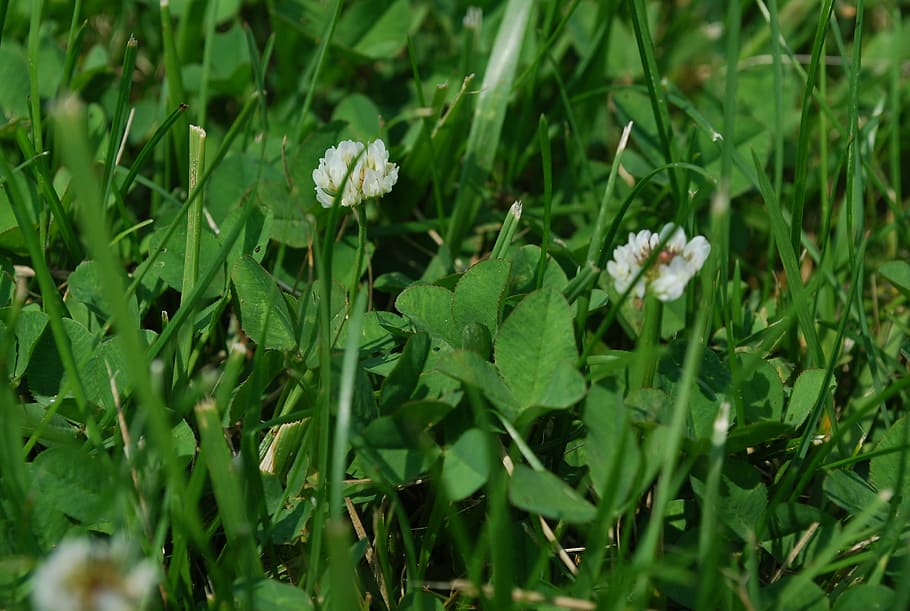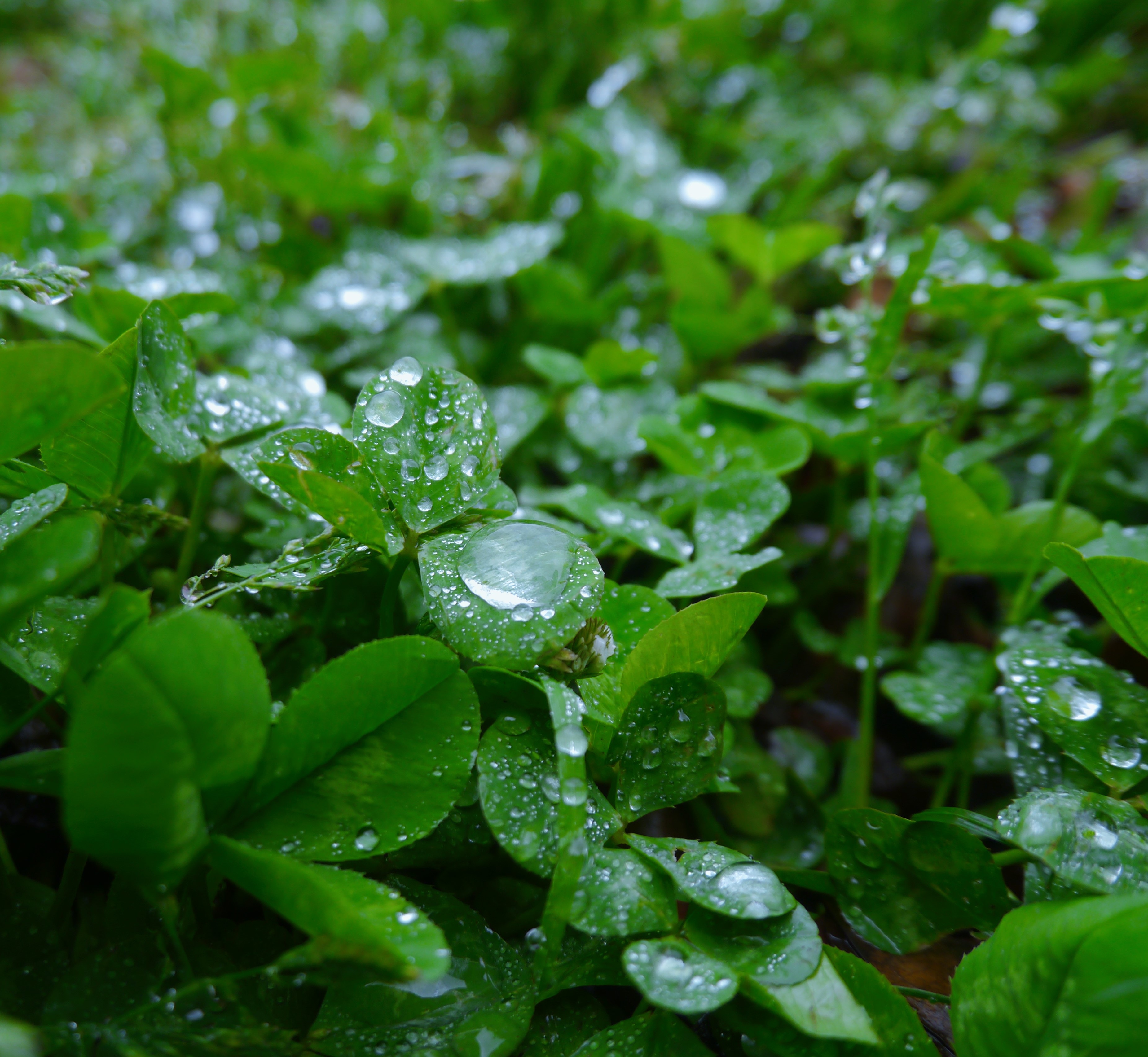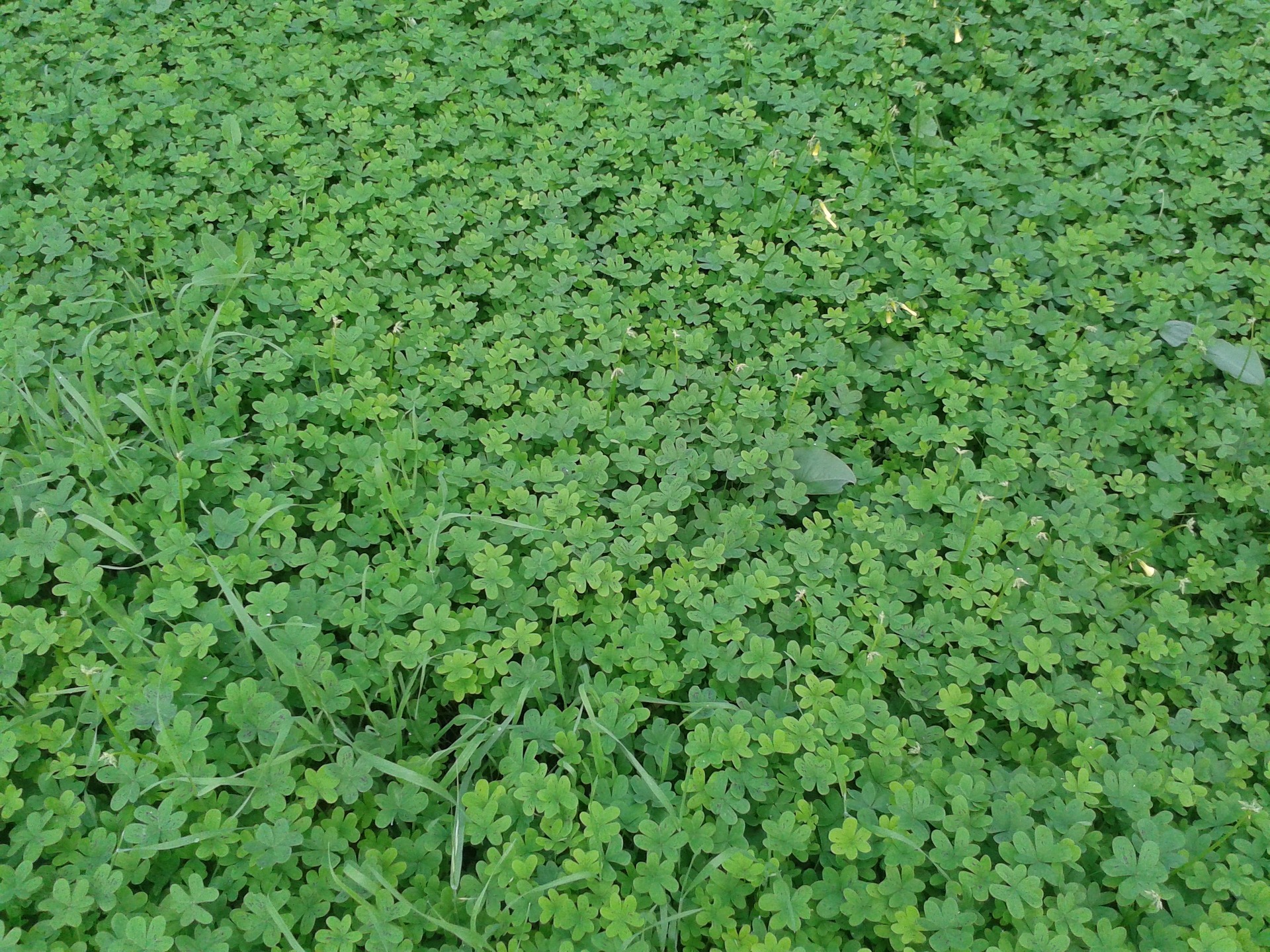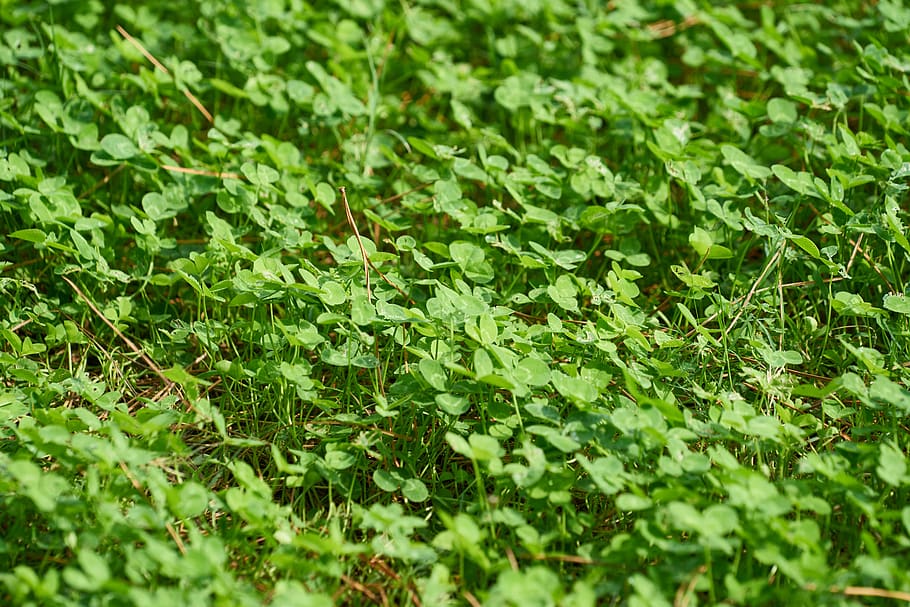Photo credit: pxfuel
Looking for a lower maintenance or eco-friendly alternative to the traditional turfgrass lawn? Then you should consider microclover. It’s been popular in European yards for decades and is gaining traction in the US as homeowners are moving away from turf because of its high water and fertilizer needs.
So let’s talk micro clover, including its pros and cons, whether it’s a good choice, and if you should do straight micro clover or interseed it with turf. We’ll also cover some of the most common frequently asked questions.
We hope to offer you a great alternative to traditional fescues or Kentucky bluegrass that still provides a green, lush landscape.
What is Micro Clover?
The traditional Dutch white clover (Trifolium repens) that was once incredibly common in lawns—before the popularity of broadleaf pesticides—is an older, “original” version of micro clover. Micro clover (Trifolium repens v. pipolina or Trifolium repens v. pirouette) is a miniature, low-growing variety of Dutch white.
Micro clover plants are approximately one-third of Dutch clover size, growing only four to 6 inches tall at most. They don’t clump together like Dutch, so when grown in your lawn, they create more of an evenly green carpet and less like an unkempt weed that needs pulling.
The Good and Bad of Micro-Clover In Your Lawn
Before adding micro-clover to your existing lawn or completely reseeding the entire grass, you must understand there are great things about it but also some drawbacks.
Benefits of Micro-Clover
- Higher drought tolerance than most turfgrasses because of its taproot and the resulting access to deeper soil moisture. Needs about 25% less water to stay green.
- Ability to thrive in lower-fertility soils once established.
- When grown with turf, it creates a uniform, blended appearance.
- Stays low to the ground, so it doesn’t need regular mowing.
- Makes the overall hue of a lawn greener.
- Creates a soft, inviting texture to the lawn.
- Fixes nitrogen, reducing nitrogen fertilizer need.
- Decomposed microclover clippings contribute nitrogen to the soil.
- Doesn’t flower as much as white Dutch clover, so there is less risk of bee stings.
- Flowers still attract bees and other pollinators.
- Doesn’t turn brown or yellow from pet urine.
 Photo credit: pxfuel
Photo credit: pxfuel
Micro-Clover Disadvantages
- Higher seed cost than other turfgrasses but has reduced input costs over time.
- Will tolerate some shade but needs at least four hours of direct sunlight daily.
- Plants go dormant in the winter, and the foliage dies back to the ground returning usable nutrients to the soil, but there is limited ground cover until the next spring.
- Susceptible to many broadleaf herbicides.
Is Micro Clover Right For My Yard?
Or, more importantly, where does microclover grow best? It thrives in lower-fertility soils and is fairly drought-tolerant, but it isn’t a fit for all homeowners. Your yard is a good candidate for adding clover if you meet the following conditions:
- Yards with at least six to eight hours of direct, full sun with very little or no shade.
- Climates that aren’t prone to long periods of drought, and get adequate, regular rainfall.
- Regions with milder temperatures and lower relative humidity levels.
 Photo credit: pxhere
Photo credit: pxhere
Should I Choose a Straight Micro-Clover Lawn or a Mixed Lawn?
After deciding to try micro clover, the next big choice is whether you want to interseed it in your existing grass or rip everything out and plant a straight micro clover lawn.
Growing a Straight Micro-Clover Lawn
When some people decide to try something new, they go all in, but in this case, there are some things to consider before pulling your grass up to reseed it completely. A lawn composed entirely of microclover is beautiful when green, but it will come at a cost and not look so lovely come spring.
What does a 100% micro clover lawn cost to seed versus a blend of turf and microclover?
Let’s figure pricing using a 5,000 square feet seeding area as the reference.
- When straight seeding microclover, it’s recommended to sow it at two to five pounds of seed per 1000 square feet of planting area. At the low seeding rates, you’d spend $250 to seed 5,000 square feet using Deer Creek Seed’s premium microclover; at the higher rate, you’d pay about $650.
- When seeding with a blend of turfgrass and microclover, it’s recommended to sow new lawns at five pounds of seed mix per 1000 square feet of lawn and overseed at two and a half pounds per 1000 square feet. Seeding a 5,000-square-foot yard with Deer Creek Seed’s microlawn, a premium blend of microclover and turfgrass, will cost approximately $150 for a new lawn and $90 for overseeding an existing one.
 Photo credit: Sumani | Pixabay
Photo credit: Sumani | Pixabay
Do you live where winters are cold or warm?
Your climate is essential to consider when thinking about microclover.
- Homeowners in warmer, Southern climates see good results with entire micro clover lawns all year.
- In Northern climates, the plants go dormant when temperatures drop in the fall, and the foliage dies back to the ground in the winter (the roots are still alive). A monoculture leaves homeowners with a muddy, barren patch come spring until the above-ground part of the plant regrows, so many in colder climates opt to plant a blend of microclover and turfgrass.
What Types of Turfgrasses Blend Well with Micro-Clover?
One of the advantages of micro clover is that if you blend it with turfgrass, the two plants grow incredibly well together.
Turf-type tall fescue is recommended the most often to grow with micro-clover, especially dwarf types that will tolerate being mowed shorter. When you mix the two, you’ll create a lawn with exceptional drought and wear tolerance.
Kentucky bluegrass and turf-type perennial ryegrass also blend well with microclover.
Regardless of the mixture, when interseeding, always keep the microclover under 3-5% of the total seed blend. At this rate, you’ll reap the benefits of microclover without taking over the grass.
Planting Micro Clover Seed
When is the best time to plant micro clover seeds?
Micro-clover is a cool-season legume, like traditional clover and alfalfa. It can be sown as long as the ground isn’t frozen but fares best if you plant when the temperatures are cooler, and there is regular rainfall.
The optimal time for spring planting is from two weeks before the frost-free date until four weeks after. Sowing at this time allows seeds to germinate and establish a sound root system before temperatures start climbing.
Later in the season, you can successfully sow microclover seeds from late summer until approximately four weeks before the first expected fall frost. This fall timing allows new seedlings to grow and develop adequately before temperatures drop and they go dormant for the winter.
How do you plant micro clover?
When seeding microclover, follow the same steps for other clovers or turfgrass seeds. The steps vary depending on whether you are overseeding your existing lawn or starting from scratch.
For step-by-step instructions on seeding, Deer Creek Seed has guides available to help.
Micro-Clover FAQs
How much sun does micro clover require?
Microclover needs at least 4 to 6 hours of bright, direct sunlight daily. Plants will struggle in too much shade, even when it is sweltering.
How much water does micro clover need?
Like other seeds, micro clover must be watered daily to encourage germination and help establish a sturdy root system. After it establishes, it needs, on average, 25% less water than turf to keep it nice and green.
Do you need to fertilize micro clover?
One of the most significant advantages of growing microclover is the reduced fertilizer needs. Whether or not you fertilize depends on the goals you set for your lawn.
- When growing straight microclover, there is less need for nitrogen fertilizer. The plants produce their own nitrogen. You may still need to supplement P, K, and other nutrients.
- In a blended lawn of microclover and grass, if you want to grow more grass than microclover, fertilize the lawn in the spring and fall. The extra application of nutrients keeps the clover from taking over the space.
How do you mow micro clover?
If you’re growing a 100% microclover lawn, you don’t have to mow it if you’re okay with a slightly unkempt, uneven look. However, if you want an even green carpet across your landscape, you can mow it to a height of 3 to 3.5” once it grows taller. Most homeowners only need to mow their straight micro clover a handful of times a season.
When growing blended lawns, mow as often as needed to maintain the recommended turfgrass height. Microclover generally grows slower, so it will stay shorter than the turf.
Is micro clover tolerant of foot traffic?
After it establishes, micro-clover is more tolerant of foot traffic than many other types of lawn alternatives. Keeping everyone and pets off of new plants for four to six weeks is recommended to let a robust root system develop.
Is microclover suitable for pets?
Micro clover is an excellent choice for homes with pets. Unlike turfgrass, it is pretty resilient to pet urine and won’t turn yellow or brown. However, if dogs ingest a large amount of it, it may cause gastrointestinal upset.
 Photo credit: Bennilover | Flickr | CC BY-ND 2.0
Photo credit: Bennilover | Flickr | CC BY-ND 2.0
Deer Creek Seed is Here to Help
There are many fantastic reasons to add microclover to your grass or to take the leap and put in a straight microclover lawn. You will still maintain a gorgeous green yard but use less water and fertilizer, saving time on lawn maintenance.
Whatever your landscaping needs are, look no further than Deer Creek Seed! Our high-quality seed selection will help you grow the perfect lawn, and our experts are here to answer any questions!
Additional Resources
- The Illinois Extension from the Univeristy of Illinois - Urbana Champaign talks about the trend of clovers in the lawn and how microclover is making a comeback.
- Iowa State University's Extension and Outreach discusses other alternatives to traditional turf.
- The University of Maryland Department of Plant Science & Landscape Architecture has put together a fantastic bulletin if you're looking for more information on a micro clover and fescue lawn.



